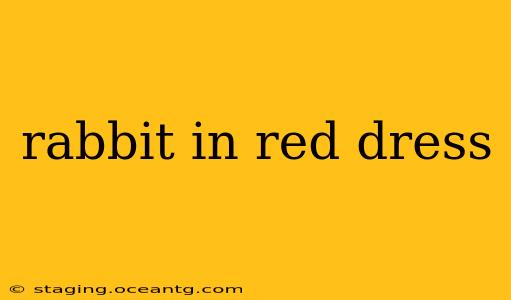The image of a rabbit in a red dress evokes a sense of playful charm and unexpected elegance. This seemingly simple concept has captivated artists, designers, and audiences for decades, sparking curiosity and inspiring countless interpretations. But what lies beneath the surface of this captivating image? Let's delve into the world of the rabbit in a red dress, exploring its artistic representation, cultural significance, and the fascinating phenomenon of anthropomorphism.
Why Are Rabbits Often Depicted in Clothing?
Anthropomorphism, the attribution of human characteristics or behavior to animals, is a key factor in the appeal of a rabbit wearing a dress. By dressing a rabbit, we imbue it with human-like qualities, making it relatable and engaging. This allows us to project our own emotions and narratives onto the creature, creating a richer, more meaningful experience. The act of clothing an animal also highlights the contrast between the natural world and human society, creating a visually interesting and thought-provoking juxtaposition.
What Does the Color Red Symbolize in This Context?
The choice of red for the rabbit's dress adds another layer of complexity. Red is a powerful and versatile color, often associated with passion, energy, danger, and even seduction. In the context of a rabbit in a red dress, the color can amplify the sense of the rabbit's personality. Is it a bold and daring rabbit? Or perhaps a mischievous and playful one? The color red enhances the overall narrative and allows for varied interpretations.
Are There Specific Artists Known for This Motif?
While there isn't one single artist solely known for the "rabbit in a red dress" motif, this imagery appears in various forms across different artistic mediums. Many children's book illustrators, for instance, utilize this whimsical image to create endearing and memorable characters. Furthermore, the concept frequently appears in fashion design, particularly in children's clothing, where the image is often used to create a fun and appealing aesthetic. Searching online for "rabbit in red dress art" will reveal a plethora of examples, highlighting the enduring appeal of this motif.
What Cultural Significance Does This Image Hold?
The cultural significance of a rabbit in a red dress is multifaceted. In some cultures, rabbits symbolize fertility and abundance. The addition of the red dress could be interpreted as enhancing these symbols, representing passion and vitality. In other contexts, the image might simply be a playful, non-serious depiction of an animal in clothing, offering a lighthearted escape from reality. The interpretation often depends on the specific context in which the image is presented.
Where Can I Find Examples of This Imagery?
Finding examples of rabbits in red dresses is surprisingly easy. A quick search on platforms like Pinterest, Etsy, and even Google Images will reveal a vast collection of artwork, clothing designs, and other creative manifestations of this whimsical theme. From illustrations in children's books to unique fashion pieces, the rabbit in a red dress continues to inspire creativity and capture the imagination.
Is the rabbit in a red dress a recurring symbol in literature or film?
While not a universally recognized symbol like a red rose, the image of a rabbit in a red dress does pop up in various instances of children's literature and occasionally in animated films. Its use is often tied to creating a memorable and slightly quirky character. It's less about a deep-seated symbolic meaning and more about the visual appeal and the whimsical nature it projects. Looking for this imagery in children’s books featuring anthropomorphic characters is a good starting point for discovering more examples.
In conclusion, the seemingly simple image of a rabbit in a red dress offers a captivating blend of artistic expression, cultural interpretation, and the human tendency to anthropomorphize animals. Its enduring appeal lies in its ability to spark imagination, evoke a range of emotions, and provide a platform for diverse creative explorations.
